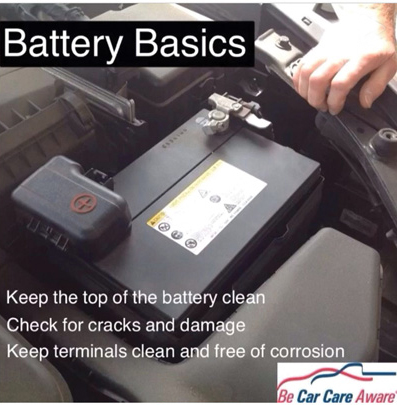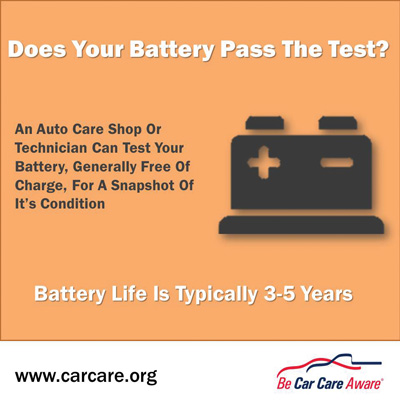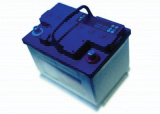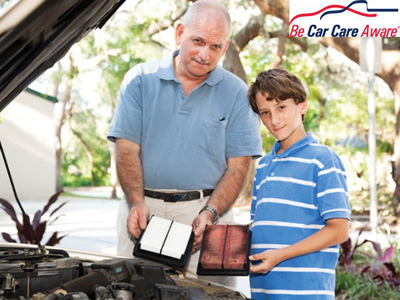| The Car Care Council |
 |
FEELING THE SUMMER HEAT? YOUR CAR BATTERY IS TOO!
If the heat of summer is wearing you down, it is likely taking its toll on your car battery too. Contrary to popular belief, summer highs rather than winter lows pose the greater threat to battery life according to the non-profit Car Care Council.
Sooner or later, all batteries have to be replaced. Excessive heat and overcharging are the two main reasons for shortened battery life. Heat causes battery fluid to evaporate thus damaging the internal structure of the battery. A malfunctioning component in the charging system, usually the voltage regulator, allows too high a charging rate leading to slow death for a battery.
“When most motorists think of dead batteries that cause starting failure they think of severe winter weather, but summer heat is the real culprit,” said Rich White, executive director, Car Care Council. “Many battery problems start long before the temperatures drop. Heat, more than cold, shortens battery life.”
Colder temperatures increase the thickness of the engine oil making the engine harder to turn over causing the battery to have to work more. These factors lead to harder starting.

To get the most life out of a battery the Car Care Council suggests the following simple steps:
- Be sure the electrical system is charging at the correct rate; overcharging can damage a battery as quickly as undercharging.
- If your battery is the type that needs to be topped off, check it regularly, especially in hot weather. Add distilled water when necessary.
- Always replace a battery with one that’s rated at least as high as the one originally specified.
- Keep the top of the battery clean. Dirt becomes a conductor which drains battery power. Further, as corrosion accumulates on battery terminals it becomes an insulator inhibiting current flow.
Driving habits such as frequent engine on/off cycles will cause more wear on the starter than a simple back and forth to work. Other factors include driving and weather conditions, mileage, vehicle age and excessive electrical draws like in-vehicle entertainment systems. Check the battery if you notice headlights and interior lights dim, accessories that fail to operate, or the “check engine” and/or battery light illuminated.

BATTERY CARE
| Your car’s radio and headlights, plus a slew of other important functions, are powered by an electrical current generated by your vehicle’s engine. A vital part of generating electricity is having a place to store it while it’s not being used which is where a car battery comes into play. |
 |
The battery holds electrical energy while a car is off in order to help the engine turn over and create a spark to start internal combustion. Without a working battery your car will not be able to start. If you perform proper maintenance, however, an average car battery can start your car reliably for roughly four years.
The typical car battery found in most modern cars is of a lead-acid storage design. While we don’t suggest it, if you were to look beneath the surrounding casing of a standard 12-volt car battery, you’d find six connected cells. In these cells is a toxic concoction of hydrogen oxygen gasses and sulfuric acid which can burn your skin on contact. The American National Standards Institute advises wearing gloves and eye protection when handling your car battery. We’d also recommend you not smoke around your car battery.
A car’s battery is connected by two metal terminals – one positive (+) and one negative (-) – located at the top of the battery’s casing. These terminals can develop buildup over time which can inhibit electrical flow. If there are encrusted deposits on the battery carefully clean the terminals with a wire brush dipped in baking soda and water. This will ensure that current flows more freely through the terminals and then to necessary components.
Check that the cable ends are securely attached to the terminals. A loose cable end can cause a car not to start and mimics the symptoms of a dead battery. Be extremely careful when disconnecting the battery cables from the brackets. If you do need to disconnect the battery, remove the negative terminal first, then the positive. Removing the positive terminal before the negative can result in a spark which could ignite anything flammable in the engine compartment and cause an explosion.
The battery is secured to the inside of the engine bay or trunk with brackets to prevent it moving around under normal driving conditions. Make sure these brackets are tight. A loose battery can be knocked around while driving causing the life of the battery to be shortened dramatically.
Safety
Remember that the typical car battery found in modern cars is of a lead-acid storage design. Inside the battery are six connected cells in which a toxic concoction of hydrogen-oxygen gasses and sulfuric acid reside. These will burn your skin on contact so we recommend wearing gloves and eye protection when handling your car battery. We’d also recommend you not smoke around your car battery.
TIME TO CHANGE YOUR VEHICLE’S CABIN AIR FILTER
Before winter sets in is a good time to check your cabin air filter after it’s been working hard all spring, summer and fall. Cabin air filters clean the incoming air and remove allergens, and according to the Car Care Council, should be replaced every 12,000 to 15,000 miles or per the owner’s manual.
The cabin air filter helps trap pollen, bacteria, dust and exhaust gases that may find their way into a vehicle’s air conditioning and heating and ventilation systems. The filter also prevents leaves, bugs and other debris from entering the heating, ventilating and air conditioning (HVAC) system.
A dirty or clogged cabin air filter can cause musty odors in the vehicle and cause contaminants to become so concentrated in the cabin that passengers actually breathe in more fumes and particles when riding in the car compared to walking down the street.
A restricted cabin air filter can also impair airflow in the HVAC system possibly causing interior heating and cooling problems important for staying comfortable this winter. Over time, the heater and air conditioner may also become damaged by corrosion.
Most filters are accessible through an access panel in the HVAC housing, which may be under the hood or in the interior of the car. An automotive service technician can help locate the cabin filter and replace it according to the vehicle’s owner manual. Some filters require basic hand tools to remove and install the replacement filter; others just require your hands. Filters should not be cleaned and reinstalled, instead, they should be replaced.
“Many people don’t even know they have a cabin air filter in their vehicle and most others aren’t aware of the health benefits of changing it,” said Rich White, executive director, Car Care Council. “Checking the cabin air filter is a simple preventive maintenance step that goes a long way toward protecting passengers as well as the vehicle’s HVAC system.”

FOUR SYMPTOMS OF A SICK VEHICLE COOLING SYSTEM
With the hot summer temperatures on the rise, knowing the symptoms of a sick vehicle cooling system are critical to your summer driving plans since cooling system failure is a leading cause of vehicle breakdowns. The most noticeable symptoms are overheating, leaks, a sweet smell of antifreeze and repeatedly needing to add coolant, according to the Car Care Council.
“Neglecting your cooling system can result in serious damage and even complete engine failure which would put a sudden end to your summer road trip,” said Rich White, executive director, Car Care Council.
“If the cooling system doesn’t receive regular maintenance it’s not a question of whether it will fail, but rather when it will fail. Performing regular checkups of belts, hoses, the water pump and fluids will ensure your car remains properly cooled and healthy for many miles down the road.”

The primary job of the engine’s cooling system is to remove the heat that is generated during the combustion process. The coolant temperature can be well over 200 degrees and that heat has to go somewhere otherwise engine components are going to start failing.
The key parts of the cooling system remove the heat from the engine and automatic transmission and dispel it to the air outside. The water pump circulates coolant through the engine. The coolant absorbs heat and returns it to the radiator where heat is dissipated. The thermostat regulates the coolant temperature to keep it consistent for efficient engine operation.
A major factor that affects the replacement of cooling system parts is the frequency of regular maintenance such as coolant changes. Motorists should consult their owner’s manual for specific recommendations about how often to change antifreeze and flush the coolant system. A coolant flush and fill is basic to cooling system maintenance as new antifreeze helps the engine run cooler and a flush removes dirt or sediment that could damage other cooling system parts.
The coolant level should be checked regularly at the reservoir and motorists are reminded to NEVER open a hot radiator cap. If the coolant is low, a 50/50 mix of approved antifreeze and distilled water should be added.
Motorists can also do a visual inspection of hoses, belts and the radiator to help identify cooling system problems before they escalate. Radiator leaks, bulging hoses or frayed and cracked belts are clues that the cooling system is in need of maintenance.
Additional signs of cooling system problems include the vehicle temperature gauge rising near the danger zone, coolant leaks, steam or hissing sounds under the hood or the distinct smell of an engine that’s running hot.
The Car Care Council’s free personalized schedule and email reminder service is a simple way to help you take better care of your vehicle this summer and throughout the year. It is an easy to use resource designed to help you drive smart, save money and make informed decisions.

© 2014 TLC Magazine Online, Inc. |